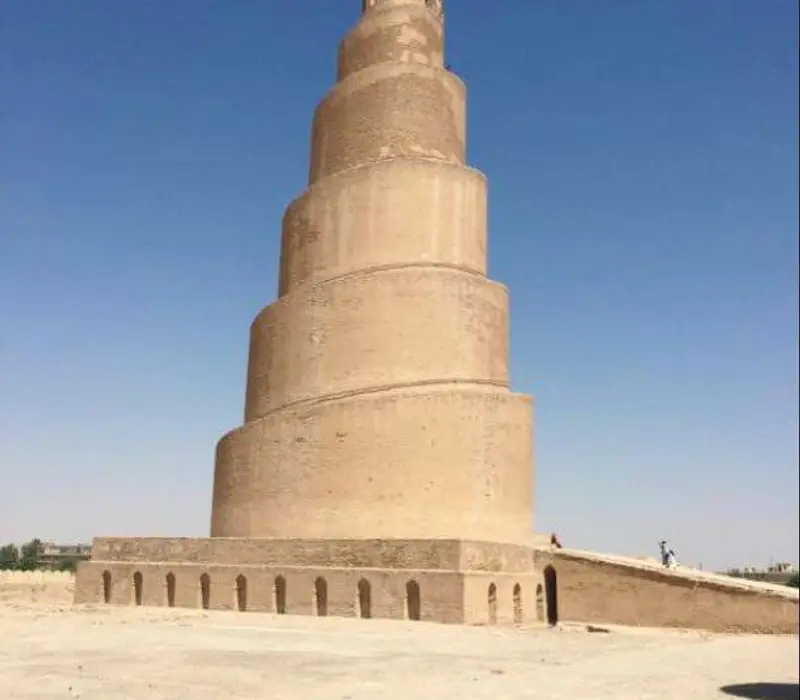The Majestic Malwiya Minaret of Samarra: A Spiraling Symbol of Islamic Heritage

The Foundation of the Malwiya Minaret
Constructed in 237 AH (AD 851) by the Abbasid Caliph Al-Mutawakkil, the Malwiya Minaret forms part of the Great Mosque of Samarra. At that time, Samarra was the capital of the Abbasid Caliphate, an empire that spanned much of the Islamic world. The city, renowned for its grandeur and influence, was a center of art, culture, and politics. The minaret’s construction is attributed to the famed architect Dhel al-Yacoubi, whose innovative design reflects a blend of artistry and function. The minaret’s role extended beyond serving as a traditional call-to-prayer platform; it also symbolized the Abbasid Caliphate’s power and religious devotion.
A Unique Spiral Design
What sets the Malwiya Minaret apart from other Islamic structures is its spiral shape, a design rarely seen in Islamic architecture. Rising 52 meters into the sky, the minaret is built from mudbrick and baked clay, materials typical of the time. The spiral design consists of five cylindrical tiers that wind counterclockwise, giving the minaret its iconic and easily recognizable silhouette. Unlike conventional minarets, which are typically straight and slender, the Malwiya’s spiral design invites curiosity and admiration, reflecting the Abbasid era's architectural boldness.
This counterclockwise spiral shape is thought to be inspired by ancient Mesopotamian ziggurats, adding a layer of historical continuity to the region’s architectural heritage. Travelers visiting the Malwiya Minaret today can appreciate the ingenuity behind this design, which has withstood the test of time for over a millennium.
Architectural Marvel of Its Time
The Malwiya Minaret rests upon a square base, measuring 33 meters on each side and standing 3 meters high. From this solid foundation rises the spiraling tower, with 399 steps leading to its top. These steps form a continuous pathway that ascends to a circular platform, offering breathtaking views of the surrounding city. This platform, known locally as Al-Jawn, features seven windows and serves as the spot from which the muezzin would historically call the faithful to prayer.
This towering structure is located 27.25 meters from the mosque’s northern wall, a deliberate design choice to emphasize the minaret’s grandeur without overshadowing the mosque’s importance. The distance between the minaret and the mosque’s prayer hall also provided space for worshipers to gather in large numbers, showcasing the mosque’s role as a communal center.
The Role of the Minaret in Islamic Practice
The primary function of the Malwiya Minaret, like all minarets, was to serve as a platform for the adhan—the Islamic call to prayer. The muezzin would ascend the steps to the top of the minaret, where they would call the faithful to prayer five times a day. From this vantage point, the sound of the call could carry across the city of Samarra, summoning worshipers to the Great Mosque.
While the Malwiya Minaret’s height and spiral design are certainly impressive, its cultural and religious significance is equally profound. The act of climbing the 399 steps to perform the call to prayer symbolized the ascension of the human spirit toward the divine, a powerful metaphor that resonated deeply with the faithful. For centuries, this towering structure echoed with the sounds of devotion, solidifying its place in Islamic tradition.
A Minaret of Over 1,000 Years of History
The Malwiya Minaret is over 1,000 years old, making it one of the oldest surviving minarets in the world. Its age alone makes it a remarkable historical artifact, but it is the stories embedded in its walls that captivate visitors today. Over the centuries, the minaret has witnessed the rise and fall of empires, survived invasions, and stood as a silent witness to the passage of time.
In recent history, the minaret suffered damage during military conflicts in Iraq, particularly during the U.S.-led invasion in 2003. However, efforts to preserve and protect this ancient structure have been ongoing. The Iraqi government and various international organizations have recognized the Malwiya’s importance as a symbol of Iraq’s cultural heritage, and restoration projects are underway to ensure its survival for future generations.
Visiting the Malwiya Minaret Today
For travelers seeking to explore Iraq’s historical treasures, a visit to the Malwiya Minaret is an absolute must. Standing tall in the ancient city of Samarra, the minaret is easily accessible from Baghdad, the country’s capital. Samarra itself is a UNESCO World Heritage site, recognized for its cultural and architectural significance. The Great Mosque and the Malwiya Minaret are key attractions, drawing visitors from around the world who wish to experience the grandeur of the Abbasid era firsthand.
When visiting the site, travelers can marvel at the intricate craftsmanship of the minaret and take in the panoramic views from the base of the structure. Although visitors are no longer allowed to climb the spiral staircase due to safety concerns, the minaret’s imposing presence is enough to inspire awe and reverence.
To visit the Malwiya Minaret, there is a modest entrance fee of 25 Iraqi dinars. However, it’s important to note that the minaret may occasionally be closed for maintenance, so it’s recommended to check ahead to ensure it is open before planning your trip.
To enhance your visit, you can explore the surrounding ruins of Samarra, including the remains of the Great Mosque. These ruins offer a glimpse into the splendor of the Abbasid capital, providing context to the Malwiya Minaret’s significance within the broader historical landscape of Iraq.
For a seamless visit, you can use this maps.app.goo.gl7 to locate the Malwiya Minaret and plan your journey accordingly.